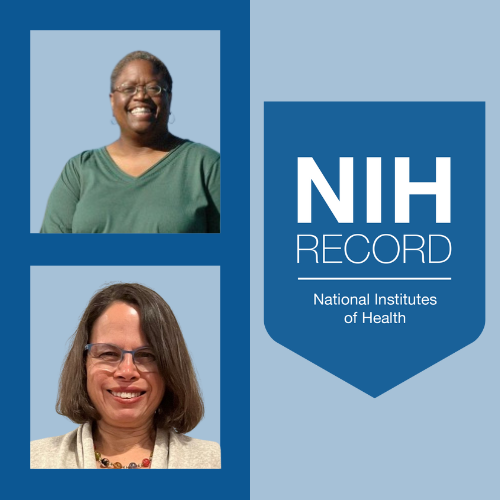
As the editor and associate editor of the National Institutes of Health’s (NIH) biweekly employee newsletter, The NIH Record, Carla Garnett, and Dana Talesnik work tirelessly to publish informative, inspiring, and relevant stories for the NIH community. I sat down with them in a recent interview to learn more about the publication’s history, the pair’s careers in journalism, and their journey at The Record.
From Humble Beginnings to Editorial Excellence at NIH
The Record began in 1949 as a four-page employee newsletter, circulated from office to office. It has since grown into a 12-page publication that Garnett and Talesnik lovingly refer to as the ‘hometown paper.’ The Record explores discoveries by NIH scientists, profiles NIH staff, and often includes breathtaking scientific photography straight from NIH labs.
To produce the newsletter, staff contributors conduct interviews, attend lectures, engage in research, and write articles. Those articles are then edited, incorporated into the current issue’s layout, published, and uploaded to The Record’s online channels, including Facebook and @NIHRecord on Twitter.
“It’s like doing four or five jobs in one,” Talesnik laughs. And the pace never slows – every two weeks, another issue publishes. “In my head, I’m always planning the next issue.”
Forging a Unique Path with Some Unforeseen Turns

Although Garnett has worked for The Record since 1988, journalism was not her initial career choice.
“My dream job was to be a novelist but to pay the bills, I knew I had to start in some other way first — so I wanted to be an advertising executive on Madison Avenue,” Garnett says. Initially, she planned to attend the Fashion Institute of Technology (FIT) in New York to hone her skills in advertising and communications. However, Garnett’s participation in an NIH junior fellowship program would change the course of her life.
The summer after she graduated high school, Garnett worked as a fellow at the Clinical Center, writing about public affairs. “I loved it and my focus completely started to tilt, even before I set foot on FIT’s campus.” At the program’s conclusion, NIH offered Garnett a job to write for The Record — which she accepted.
Garnett has worked for the publication ever since and later went on to receive her master’s in journalism. Two years ago, Garnett succeeded her predecessor and mentor, Rich McManus, upon his retirement.
Inspiring a Lasting Legacy by Embracing Change

Talesnik’s path to The Record was not as direct. Talesnik studied journalism in her undergraduate studies where she wrote for her university’s daily newspaper. She went on to pursue Russian and East European Studies for her master’s degree. Upon graduation, Talesnik worked at the Woodrow Wilson Center in Washington, D.C., for 12 years, where she created and produced the think tank’s newsletter.
After deciding to move to Maryland with her husband, she wanted a change. Talesnik applied for an NIH position to write for both The Record and another newsletter. “When I interviewed, it all clicked,” she remarked. She was offered the position, eventually became full-time at The Record, and later, associate editor.
As The Record’s editor and associate editor, Garnett and Talesnik are continually inspired by their work.
Talesnik’s passion for the work is palpable as she tells me about an article in The Record she wrote. The article documented how one young man’s struggle with a rare kidney cancer led to another young man’s survival. Since the article was published, Talesnik has received notes from readers with the same gene variant who now get screened for this cancer each year. “It was just this incredible feeling — my story helps save lives.”
Breathing Life into Words Through Purposeful Storytelling
Garnett and Talesnik’s hard work and creativity at The Record have also helped ensure NIH employees stay informed of the agency’s innovations, initiatives, and people who make them happen.
“We have the best jobs in the world because we get to tell stories about the science, the scientists, and the patients.”
Be a Valuable Part of Those Stories
Even after 35 years of service at The Record, Garnett remains passionate about finding relevant stories that resonate with readers. If readers have a question or idea, she says to let the team know. “We use feedback and want it to be a place of engagement,” says Garnett. “You just tell us, point us in the direction — we’ll go out and write the story.”
Do you have a story idea for us? Do you want to submit a guest blog? If it's about equity, diversity, or inclusion, please submit to edi.stories@nih.gov.
For news, updates, and videos, subscribe or follow EDI on LinkedIn, X, Blog, and YouTube.






